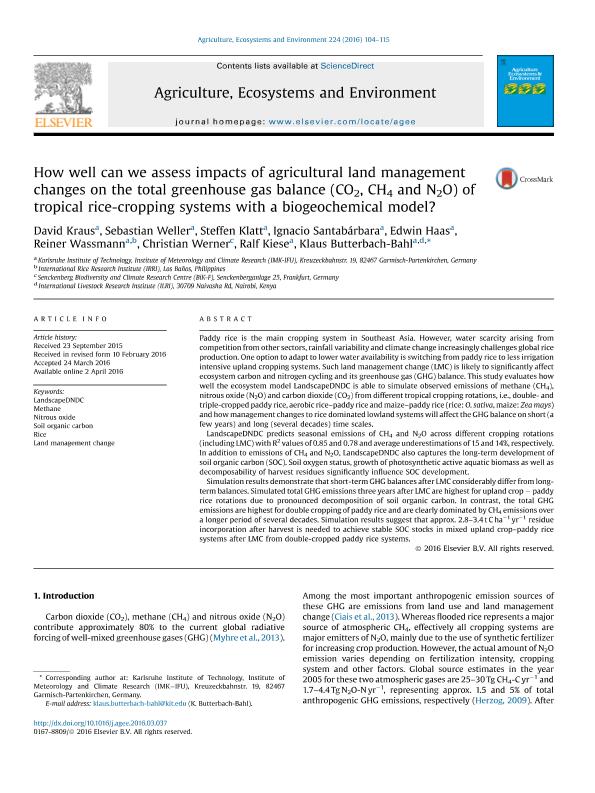Mostrar el registro sencillo del ítem
dc.contributor.author
Kraus, David
dc.contributor.author
Weller, Sebastian Benjamin

dc.contributor.author
Klatt, Steffen
dc.contributor.author
Santabarbara, Ignacio
dc.contributor.author
Hass, Edwin
dc.contributor.author
Wassmann, Reiner
dc.contributor.author
Werner, Christian
dc.contributor.author
Kiese, Ralf
dc.contributor.author
Butterbach Bahl, Klaus
dc.date.available
2017-06-09T15:40:45Z
dc.date.issued
2016-05
dc.identifier.citation
Kraus, David; Weller, Sebastian Benjamin; Klatt, Steffen; Santabarbara, Ignacio; Hass, Edwin; et al.; How well can we assess impacts of agricultural land management changes on the total greenhouse gas balance (CO2, CH4 and N2O) of tropical rice-cropping systems with a biogeochemical model?; Elsevier Science; Agriculture, Ecosystems And Environment; 224; 5-2016; 104-115
dc.identifier.issn
0167-8809
dc.identifier.uri
http://hdl.handle.net/11336/17874
dc.description.abstract
Paddy rice is the main cropping system in Southeast Asia. However, water scarcity arising from competition from other sectors, rainfall variability and climate change increasingly challenges global rice production. One option to adapt to lower water availability is switching from paddy rice to less irrigation intensive upland cropping systems. Such land management change (LMC) is likely to significantly affect ecosystem carbon and nitrogen cycling and its greenhouse gas (GHG) balance. This study evaluates how well the ecosystem model LandscapeDNDC is able to simulate observed emissions of methane (CH4), nitrous oxide (N2O) and carbon dioxide (CO2) from different tropical cropping rotations, i.e., double- and triple-cropped paddy rice, aerobic rice–paddy rice and maize–paddy rice (rice: O. sativa, maize: Zea mays) and how management changes to rice dominated lowland systems will affect the GHG balance on short (a few years) and long (several decades) time scales. LandscapeDNDC predicts seasonal emissions of CH4 and N2O across different cropping rotations (including LMC) with R2 values of 0.85 and 0.78 and average underestimations of 15 and 14%, respectively. In addition to emissions of CH4 and N2O, LandscapeDNDC also captures the long-term development of soil organic carbon (SOC). Soil oxygen status, growth of photosynthetic active aquatic biomass as well as decomposability of harvest residues significantly influence SOC development. Simulation results demonstrate that short-term GHG balances after LMC considerably differ from long-term balances. Simulated total GHG emissions three years after LMC are highest for upland crop − paddy rice rotations due to pronounced decomposition of soil organic carbon. In contrast, the total GHG emissions are highest for double cropping of paddy rice and are clearly dominated by CH4 emissions over a longer period of several decades. Simulation results suggest that approx. 2.8–3.4 t C ha−1 yr−1 residue incorporation after harvest is needed to achieve stable SOC stocks in mixed upland crop–paddy rice systems after LMC from double-cropped paddy rice systems.
dc.format
application/pdf
dc.language.iso
eng
dc.publisher
Elsevier Science

dc.rights
info:eu-repo/semantics/openAccess
dc.rights.uri
https://creativecommons.org/licenses/by-nc-nd/2.5/ar/
dc.subject
Landscapedndc
dc.subject
Methane
dc.subject
Notrous Oxide
dc.subject
Soil Organic Carbon
dc.subject
Rice
dc.subject
Land Management Change
dc.subject.classification
Geoquímica y Geofísica

dc.subject.classification
Ciencias de la Tierra y relacionadas con el Medio Ambiente

dc.subject.classification
CIENCIAS NATURALES Y EXACTAS

dc.title
How well can we assess impacts of agricultural land management changes on the total greenhouse gas balance (CO2, CH4 and N2O) of tropical rice-cropping systems with a biogeochemical model?
dc.type
info:eu-repo/semantics/article
dc.type
info:ar-repo/semantics/artículo
dc.type
info:eu-repo/semantics/publishedVersion
dc.date.updated
2017-06-06T14:42:43Z
dc.journal.volume
224
dc.journal.pagination
104-115
dc.journal.pais
Países Bajos

dc.journal.ciudad
Amsterdam
dc.description.fil
Fil: Kraus, David. Karlsruhe Institute of Technology. Institute of Meteorology and Climate Research; Alemania
dc.description.fil
Fil: Weller, Sebastian Benjamin. Consejo Nacional de Investigaciones Científicas y Técnicas. Centro Científico Tecnológico Conicet - Córdoba. Instituto Multidisciplinario de Biología Vegetal. Universidad Nacional de Córdoba. Facultad de Ciencias Exactas Físicas y Naturales. Instituto Multidisciplinario de Biología Vegetal; Argentina. Karlsruhe Institute of Technology. Institute of Meteorology and Climate Research; Alemania
dc.description.fil
Fil: Klatt, Steffen. Karlsruhe Institute of Technology, Institute of Meteorology and Climate Research; Alemania
dc.description.fil
Fil: Santabarbara, Ignacio. Karlsruhe Institute of Technology, Institute of Meteorology and Climate Research; Alemania
dc.description.fil
Fil: Hass, Edwin. Karlsruhe Institute of Technology, Institute of Meteorology and Climate Research; Alemania
dc.description.fil
Fil: Wassmann, Reiner. International Rice Research Institute; Filipinas. Karlsruhe Institute of Technology, Institute of Meteorology and Climate Research; Alemania
dc.description.fil
Fil: Werner, Christian. Senckenberg Biodiversity and Climate Research Centre; Alemania
dc.description.fil
Fil: Kiese, Ralf. Karlsruhe Institute of Technology, Institute of Meteorology and Climate Research; Alemania
dc.description.fil
Fil: Butterbach Bahl, Klaus. Karlsruhe Institute of Technology, Institute of Meteorology and Climate Research; Alemania. International Livestock Research Institute; Alemania
dc.journal.title
Agriculture, Ecosystems And Environment

dc.relation.alternativeid
info:eu-repo/semantics/altIdentifier/url/http://www.sciencedirect.com/science/article/pii/S0167880916301839
dc.relation.alternativeid
info:eu-repo/semantics/altIdentifier/doi/http://dx.doi.org/10.1016/j.agee.2016.03.037
Archivos asociados
